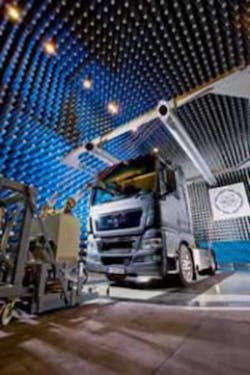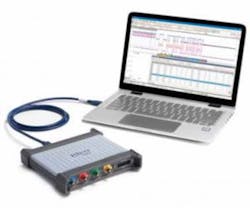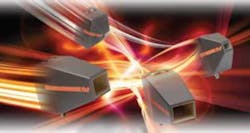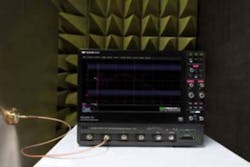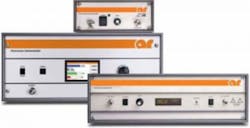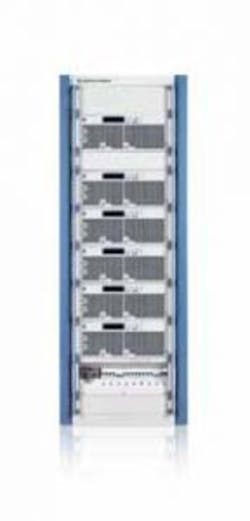Instruments, software, systems pave road to compliance
Courtesy of Rohde & Schwarz
An effective electromagnetic compatibility strategy begins with design and extends through compliance test. In addition, the related topics of signal integrity and power integrity must be addressed early on to avoid costly redesign efforts—either to achieve compliance or to ensure that products function as intended. Vendors offer a variety of test and measurement and related equipment and software to help throughout the product development cycle—from benchtop oscilloscopes and compact USB-powered signal and spectrum analyzers to large test chambers (Figure 1).
“When it comes to EMI/EMS measurements, debug, precompliance, or full compliance tests, Rohde and Schwarz enables customers at every step of their development,” said Faride Akretch, marketing manager. “We offer test and measurement solutions for the entire development cycle, as well as the full depth of products for full-compliance tests, including chambers, amplifiers, antennae, and accessories.”
EMI receivers represent one class of instruments the company offers. With those instruments, Akretch said, “We help our customers by offering test results that are beyond a simple pass or fail. Customers today demand from their test labs an improved capability to not only detect emissions, but to also characterize the failing emissions. Combining the traditional spectrum plot with the real-time mode spectrogram and persistence displays provides the user with a variety of tools that can be used to identify the root-cause of failed EMC tests.”
He explained that time-domain scan provides real-time spectrum feedback thousands of times faster than do traditional spectrum-analyzer measurements. Real-time-mode spectrogram displays show a color-coded representation of signal strength over time. “This is extremely useful when examining the time nature of signals and when measuring pulse repetition rates without resorting to the zero-span mode in a swept spectrum analyzer,” he said.
Finally, he said, “Real-time mode persistence displays amplitude as a function of the percentage of time the signal was at that amplitude. This gives the EMC designer the ability to visualize time-multiplexed signals, or ‘signals under signals,’ eliminating costly multiple rounds of full EMC testing.”
Tektronix is addressing EMC test on a variety of fronts. “Our product solutions enable unparalleled levels of measurement accuracy, ease of use, and cost effectiveness in support of EMI troubleshooting and precompliance test, covering challenges such as conducted emissions and radiated emissions,” said Wilson Lee, technical marketing manager. He said that in January, Tektronix launched EMCVu software, which supports precompliance testing and troubleshooting for the company’s real-time spectrum-analyzer line (Figure 2), including the USB-powered RSA306B. EMCVu serves as an enhancement to SignalVu-PC, which runs on a laptop or tablet and controls the analyzer.
EMCVu provides precompliance test and troubleshooting capability through the SignalVu-PC user interface. EMCVu offers an easy-to-learn wizard with built-in support for CISPR (Comité International Spécial des Perturbations Radioélectriques, or International Special Committee on Radio Interference) and other standards. It also supports push-button accessory selection and setup. Functions include automated ambient noise capture, multifailure remeasurement, and harmonic markers for in-depth analysis. Users can save experiment results with notes and images into a configurable report in PDF or RTF formats.
Other products with applicability to EMC test, Lee said, range from the 5 Series MSO mixed-signal oscilloscope, introduced in June 2017, to its DMM6500 6½-digit digital multimeter and DAQ6510 6½-digit data acquisition and logging multimeter system, launched in April.
From amplifiers to antennas
AR/RF Microwave Instrumentation has introduced a variety of products over the last year, including amplifiers, systems, antennas, and accessories for the EMC industry. With respect to amplifiers, the company expanded the 10-kHz to 1,000-MHz U Series solid-state power-amplifier power offerings. The lineup now includes 1-, 2.5-, 5-, 10-, 25-, 50-, 100-, and 250-W CW Class A models. The company also updated its 10-kHz to 400-MHz solid-state power amplifiers with the 100A400A, 175A400, 250A400, and 350A400 models, and it designed and shipped what the company called the industry-leading 10,000-W 80- to 1000-MHz solid-state power amplifier—Model 10000W1000A. In addition, it expanded its 0.7- to 6.0-GHz Class A solid-state power amplifier offerings with the 175S1G6, and it redesigned the 6.0-to 18-GHz solid-state power amplifiers; current power offerings are 20 and 40 W CW, Class A. The company also introduced new dual-band, solid-state power amplifiers covering 10 Hz to 400 MHz and 0.7 to 18 GHz with power levels up to 150 W in select bands, and it increased the power offerings of 1- to 6-GHz hybrid power modules to 50 W Class A and 100 W Class AB.
In addition to amplifiers, AR RF/Microwave Instrumentation has introduced new or upgraded antennas, power sensors, software, and test systems. For example, the company has introduced new Trapezoidal Log Periodic Antennae operating from 700 MHz to 12 GHz at up to 600 W and from 700 MHz to 7.5 GHz at up to 1,200 W. The company is also now offering average/pulse USB power sensors operating up to 8 GHz, it added dual directional couplers to match available amplifiers, and it introduced four models of innovative field-generation systems—its AA Series solid-state amplifier and horn-antenna combinations—operating from 18 to 40 GHz and producing fields up to 50 V/m (Figure 3).
In addition, the company updated its emcware EMC test software, introduced a cost-reduced RF conducted-immunity generator system, introduced the redesigned, configurable SC2000 RF switch control platform, and continued the development of its Multistar multitone RF radiated-immunity test systems, which cover 10 kHz to 6 GHz. Finally, the company completed recertification of all products for global compliance standards.
Class A and AB amplifier
Rohde & Schwarz has recently introduced several elements that round out its portfolio of EMI test capabilities, according to Akretch, including the R&S BBA 130 amplifier family. “They are the first amplifiers in the world that allow the user to tune the transmission characteristics to meet specific application requirements,” he said. “The user can adjust the operating point of the transistors between class A and AB during operation. Even the mismatch tolerance at the output can be changed so that more power is available. An R&S BBA130 can amplify fast pulsed signals with low distortion as well as signals with a high voltage standing wave ratio (VSWR).” The BBA130 family offers frequency ranges that cover 80 MHz to 6 GHz and output powers of 22 W to 4,200 W.
The company has also enhanced its test software portfolio with the introduction of R&S ELEKTRA, geared to developers who want to check EMC performance during development. “R&S ELEKTRA replaces the proven R&S ES-SCAN software and supports all of the company’s current EMC test receivers and spectrum analyzers,” Akretch said.
These products complement instruments such as the 2-Hz to 44-GHz ESW EMI test receiver, which, Akretch said, offers “…performance and usability that goes far beyond traditional analyzer and pass/fail results,” offering high dynamic range and measurement accuracy to meet the stringent requirements for certification measurements in line with CISPR, EN, MIL‑STD-461, DO‑160, and FCC standards. “With its FFT-based time-domain scan, the R&S ESW captures and weighs disturbance spectra in virtually no time,” he said. “The instrument’s real-time spectrum-analysis capability, with 80-MHz bandwidth and spectrogram function, permits a detailed analysis of disturbance signals and their history.”
EMI receiver requirements
Keysight Technologies also offers an EMI receiver in the form of its MXE instrument. Jeff Hu, product manager, Communications Solutions Group, pointed to several Keysight publications that spell out the requirements for, and use of, such instruments. One application note, for example, reports that a receiver used for commercial compliance testing must comply with CISPR 16-1-1, while a receiver used for military compliance testing must comply with MIL-STD-461. These requirements focus on factors such as frequency range and reference or resolution bandwidths. “Additional EMI receiver features that make measuring easier and more efficient, but are not requirements by CISPR 16-1-1 or MIL-STD-461, include limit lines, limit pass/fail indication, correction factors (for transducers), signal lists with sorting capability, time-domain scanning, and more,” according to the application note.1 Yet another note describes the compliance measurement process, covering conducted emissions measurements, including test setup and receiver configuration. It also covers radiated emissions measurements, including open-site requirements and radiated-emissions test setup.2
Hu also pointed out that Keysight offers software for EMC applications, including its EESof EDA EMPro (Electromagnetic Professional) software, which is used for EMI/EMC simulations. The EMPro 3D modeling and simulation environment can analyze the 3D electromagnetic effects of high-speed and RF/microwave components. EMPro features high-capacity time- and frequency-domain simulation technologies and integration with ADS, Keysight’s RF/microwave and high-speed design environment.3
EMC+SIPI Smposium
The EMC+SIPI Symposium, to be held July 30 to Aug. 3 in Long Beach, CA, will provide companies an opportunity to exhibit their new and current offerings for EMC test and signal-integrity and power-integrity measurements. For example, Teledyne LeCroy at the symposium will also highlight oscilloscopes with applicability to EMC test.
“WavePro HD 12-bit oscilloscopes’ high sample rate and long memory combine with Teledyne LeCroy’s dedicated EMC pulse parameter package to accurately characterize EMC test signals,” said Hilary Lustig, Teledyne LeCroy marketing communications manager. “Fast pulse rise times may require 2.5- to 4-GHz bandwidth at very high sample rates to ensure measurement confidence. WavePro HD provides the most accurate characterization using 20-GS/s sample rate, 12-bit resolution, and 0.5% gain accuracy.” In addition to exhibiting the WavePro HD oscilloscope (Figure 4) and highlighting its ESD compliance capabilities, the company will have an ESD gun in its booth for live demonstrations.
For its part, Tektronix will exhibit its 5 Series oscilloscope, RSA306B and RSA500 real-time spectrum analyzers, DMM6500 multimeter, and SignalVu-PC and EMCVu Software. In addition, the company will highlight its MDO4000C mixed-domain oscilloscope (Figure 5), which Lee described as “…the only scope in the market which enables correlated measurement between time and RF frequency domains. This enables an unparalleled level of measurement accuracy in areas of EMI troubleshooting and precompliance. The MDO4000C combines up to six instruments—with a built-in, integrated spectrum analyzer and options like a function generator.”
Lee elaborated on the spectrum analyzers, saying the RSA Series combines full-featured performance and versatility—including 40 MHz of capture bandwidth and up to a 7.5-GHz frequency range for lab or field applications. “Our RSA Series is powered by SignalVu and EMCVu software—enabling one user interface for RF and vector signal analysis across our real-time spectrum analyzers, USB spectrum analyzers, and our MDO4000C mixed-domain oscilloscope,” he said. “As part of our analyzer offering, our TTR Series vector network analyzers bring powerful performance in an ultracompact form factor—ideal for easy mobility.”
Lee also elaborated on the 5 Series MSO scopes, which offer 12 bits of vertical resolution and include reconfigurable channels called FlexChannels. “Our FlexChannels can accept either analog or digital inputs, which means they will be suited to a wider range of embedded-design projects,” he said. Each FlexChannel input can serve as one analog input channel or eight digital probe channels, enabling combinations of up to eight analog channels or up to 64 digital channels. “Other combinations, like four analog channels and 32 digital probes, or six analog channels and 16 digital channels, are also possible,” he said. The scope also features a 15.6-inch-diagonal (1,920-horizontal-pixel by 1,080-vertical-pixel) high-definition capacitive multitouch display. And as this article was going to print, Tektronix was planning the launch of a new oscilloscope lineup, which will also be exhibited at the EMC+SIPI Symposium.
AR/RF Microwave Instrumentation will highlight several of its recently introduced products at the symposium, including its 10-kHz to 1,000-MHz solid-state power amplifiers with power ratings to 250 W (Figure 6). A spokesperson for the company’s marketing and engineering departments said the amplifiers are suitable for EMC, lab, R&D, medical, wireless, and scientific applications. “We will also show our revolutionary field-generator systems capable of producing >50 V/m over the 18- to 40-GHz band, which offers a more reliable, lower-cost alternative to TWTA-based systems,” the spokesperson said.
The company will also highlight its new low-cost, complete turnkey conducted immunity test system and numerous radiated-immunity ultrahigh power systems. In addition, the company will demonstrate its enhanced multitone test system, which provides extended frequency ranges for automotive testing and other applications. The company will also highlight its ultrawide bandwidth capability by showing its 500-W 0.7- to 6-GHz Class A solid-state CW amplifier and the new 1- to 18-GHz dual-band amplifiers housed in a single package. Typical applications include radiated susceptibility, wireless testing, and research. Finally, the company’s newest division, Sunar RF Motion, will highlight products such as its EMI test antennas and antenna-positioning equipment.
Akretch at Rohde & Schwarz said his company will highlight the gamut from standalone products to full systems and services at the EMC Symposium. “Rohde & Schwarz’s focus will be on the company’s ability to cover the complete solutions for all EMI/EMS testing needs,” he said. “Solutions are ranging from receivers, amplifiers, antennae, and chambers to complete and automated test systems for all industries. Furthermore, we provide solutions for the entire development cycle”—including development, design verification, precompliance, and full compliance.
At the symposium, Akretch said, “We will highlight full compliance and precompliance solutions including EMI receivers, amplifiers, and test systems. Also shown will be products used in the development and design-verification phase, such as oscilloscopes and spectrum analyzers for EMI debug.”
In addition to the ESW EMI test receiver and the new R&S BBA130 amplifier family (Figure 7), he said, specific products on display will include the R&S BBA150 and BBL200 broadband amplifier families. “The compact BBA150 generates power in the frequency range from 9 kHz to 6 GHz and is ideal for amplitude, frequency, phase, and pulse modulation,” he said, adding that switching options for input, output, and sample ports are available for different applications.
He further stated that the R&S BBL200 instruments serve applications requiring high RF power. “They generate up to 10 kW of power in a frequency range from 9 kHz to 225 MHz,” he said. “They are liquid-cooled, solid-state, highly rugged, quiet, and efficient. Precise monitoring of all runtime parameters ensures maximum robustness and reliability.”
And finally, AMETEK Compliance Test Solutions (CTS) highlighted its emtest, Teseq, MILMEGA, and IFI brands at the International Microwave Symposium in June in Philadelphia, and the company can be expected to exhibit similar products in Long Beach. The company enables conducted and radiated immunity testing, conducted and radiated emissions testing, ESD testing, component testing, and harmonics and flicker measurements in support of military, avionics, ISO, and IEC CISPR standards. Specific products include GTEM cells (such as the GTEM 2000 with a maximum septum height of 2,000 mm), reverberation chambers, solid-state and TWT amplifiers, and complete RF test systems and customized solutions.
Presentations at the symposium
Of course, the EMC+SIPI Symposium is more than an exhibit. It features a keynote presentation plus five full days of training, technical sessions, interactive workshops and tutorials, and experiments and demonstrations. Lustig at Teledyne LeCroy said experts from her company will be participating in several presentations at the symposium. For example, Dr. Eric Bogatin, signal-integrity evangelist at Teledyne LeCroy, will describe a practical method for measuring ground bounce in microcontrollers. He will show attendees how to measure the ground bounce in a package using quiet-high and quiet-low I/O lines by employing an instrumented microcontroller board on which the number of I/O lines switching simultaneously can be controlled. He will show how an oscilloscope can monitor up to eight channels at once. He will also demonstrate that the rail noise on the die is not the same as the rail noise on the board. “It depends on which is the aggressor and which is the victim,” he will explain. “Using this simple method, anyone can measure ground bounce and rail noise in a package.”
Bogatin will also present “A Scope Measurement Puzzle to Challenge and Amuse.” This demonstration will deal with situational awareness and how the instrument we use influences our interpretation of a DUT’s figure of merit. He promises that a commonly held myth will be busted, and that attendees will gain an understanding of why it is important to be aware of what the scope is actually measuring.
Teledyne LeCroy’s Mike Hertz will be joined by Shubhankar Marathe, Giorgi Maghlakelidze, and David Pommerenke of the Missouri S&T EMCLAB to present a paper titled “Implementation and Practical Experience with an Automatic Secondary ESD Detection Algorithm.” They will point out that EMC test standards such as ISO 10605 require capturing 10 consecutive ESD pulses and recording the risetime values. They will explain how, using the Trend math operator, the test engineer can capture 10 consecutive pulses and record the results.
In addition, Bogatin will participate in tutorials on EMC fundamentals and on principles of power-integrity for power-distribution-network (PDN) design, and he will participate in an “Ask the Experts” panel on signal integrity and power integrity.
As this article was going to press, Akretch at Rohde & Schwarz said the company had yet to finalize its plans for presentations at the event. However, for EMC engineers unable to travel July 30 through Aug. 3, he said, “Rohde & Schwarz will once again be the sole master sponsor of the EMC+SIPI Online Symposium. For customers and EMC engineers and technicians that are not able to attend in person, The EMC+SIPI 2018 Online Symposium provides a parallel online learning experience to the physical symposium in Long Beach, CA.”
Dealing with EMI
The products and software tools described in this article can help you measure and predict EMC/EMI problems. But solving persisting ones can be a significant challenge. In a recent article, George Kunkel,founder and CEO of Spira Manufacturing Corp., commented on testing methods for EMI gaskets.4 And an upcoming “Product Focus” column in our October issue will highlight components you can select to minimize EMI possibilities as well as shielding and suppression products that can tame remaining EMI issues. EE
References
- Essential Capabilities of EMI Receivers, Application Note, Keysight Technologies, Aug. 3, 2014.
- Making EMI Compliance Measurements, Application Note, Keysight Technologies, Dec. 1, 2017.
- EMPro 3D Electromagnetic Modeling and Simulation Environment Integrated with your ADS Design Flow, Brochure, Keysight EEsof EDA, Sept. 26, 2017.
For more information:
AMETEK CTS
AR RF/Microwave Instrumentation
Keysight Technologies
Rohde & Schwarz
Tektronix
Teledyne LeCroy
About the Author

Rick Nelson
Contributing Editor
Rick is currently Contributing Technical Editor. He was Executive Editor for EE in 2011-2018. Previously he served on several publications, including EDN and Vision Systems Design, and has received awards for signed editorials from the American Society of Business Publication Editors. He began as a design engineer at General Electric and Litton Industries and earned a BSEE degree from Penn State.

